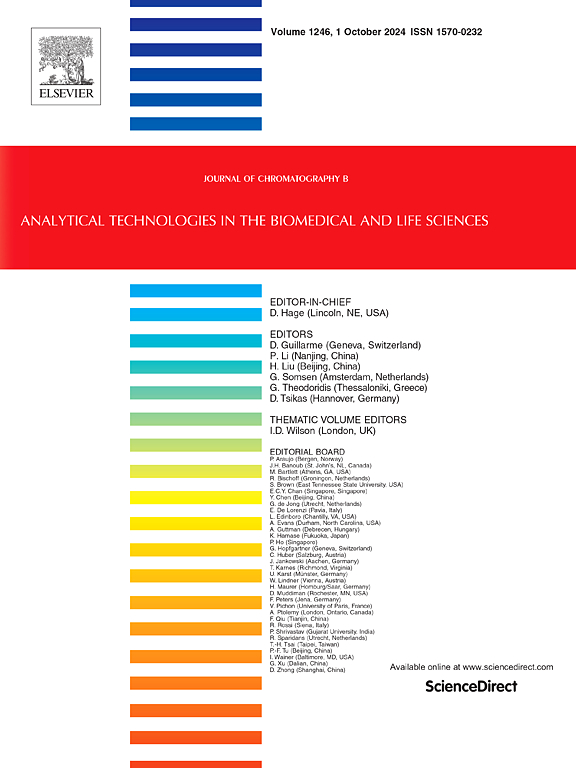固定化乙酰胆碱酯酶的 Fe3O4@MXene@PEI 气凝胶用于中草药植物抑制剂筛选
IF 2.8
3区 医学
Q2 BIOCHEMICAL RESEARCH METHODS
引用次数: 0
摘要
筛选乙酰胆碱酯酶(AChE)抑制剂是发现治疗阿尔茨海默病药物的常用策略。本文通过静电相互作用和共价键将乙酰胆碱酯酶固定在磁性聚乙烯亚胺基 MXene 气凝胶上,使其能够应用于乙酰胆碱酯酶活性测定和中草药植物抑制剂筛选。为了深入了解该复合材料的化学和物理性质,我们采用了一系列技术对其进行了分析,包括扫描电子显微镜(SEM)、傅立叶变换红外光谱(FT-IR)和 Zeta 电位分析。根据埃尔曼法的评估,所提出的 Fe3O4@MXene@PEI-AChE 复合材料具有更高的温度和 pH 值稳定性以及良好的重复使用性。经计算,固定化 AChE 的 Michaelis Menten 常数(Km)为 0.68 mmol/L。此外,还进行了一项抑制动力学研究,以验证利用固定化酶筛选抑制剂的可行性,并将石杉碱甲用作模型抑制剂。利用所提出的策略比较了 18 种治疗 AD 的常用中药的 AChE 抑制活性,结果显示黄连的水提取物和醇提取物的 AChE 抑制活性最高。最后,结合 UPLC-Q-Orbitrap 高分辨率质谱技术,对黄连提取物中的 AChE 抑制剂进行了筛选。本研究提出了一种监测 AChE 活性的可行策略,为进一步探索中药中的 AChE 抑制活性成分提供了巨大的潜力。本文章由计算机程序翻译,如有差异,请以英文原文为准。
Fe3O4@MXene@PEI aerogel immobilized acetylcholinesterase for inhibitor screening from herbal plants
Screening of acetylcholinesterase (AChE) inhibitors is a common strategy in drug discovery for treating Alzheimer’s disease. Herein, AChE was immobilized onto magnetic polyethyleneimine-based MXene aerogels through both electrostatic interactions and covalent bonds, enabling its application in AChE activity assays and inhibitor screening of herbal plants. The composite was analyzed using a range of techniques, including scanning electron microscopy (SEM), Fourier transform infrared spectroscopy (FT-IR), and Zeta potential analysis, to gain insight into its chemical and physical properties. The proposed Fe3O4@MXene@PEI-AChE composite exhibited enhanced temperature and pH stability, as evaluated by Ellman’s method, along with good reusability. The Michaelis Menten constant (Km) of the immobilized AChE was calculated to be 0.68 mmol/L. Additionally, an inhibition kinetic study was conducted to verify the feasibility of utilizing the immobilized enzyme to screen for inhibitors, with huperzine A employed as a model inhibitor. The proposed strategy was employed to compare the AChE inhibitory activity of 18 commonly used herbal medicines for treating AD, revealing both the aqueous and alcoholic extracts of Coptis chinensis as exhibiting the highest AChE inhibitory activity. Finally, the screening of AChE inhibitors in Coptis chinensis extracts were conducted by combining the proposed strategy with UPLC-Q-Orbitrap high resolution mass spectrometry. This study presents a feasible strategy for monitoring AChE activity and holds considerable potential for further exploration of AChE-inhibiting active ingredients in herbal medicines.
求助全文
通过发布文献求助,成功后即可免费获取论文全文。
去求助
来源期刊

Journal of Chromatography B
医学-分析化学
CiteScore
5.60
自引率
3.30%
发文量
306
审稿时长
44 days
期刊介绍:
The Journal of Chromatography B publishes papers on developments in separation science relevant to biology and biomedical research including both fundamental advances and applications. Analytical techniques which may be considered include the various facets of chromatography, electrophoresis and related methods, affinity and immunoaffinity-based methodologies, hyphenated and other multi-dimensional techniques, and microanalytical approaches. The journal also considers articles reporting developments in sample preparation, detection techniques including mass spectrometry, and data handling and analysis.
Developments related to preparative separations for the isolation and purification of components of biological systems may be published, including chromatographic and electrophoretic methods, affinity separations, field flow fractionation and other preparative approaches.
Applications to the analysis of biological systems and samples will be considered when the analytical science contains a significant element of novelty, e.g. a new approach to the separation of a compound, novel combination of analytical techniques, or significantly improved analytical performance.
 求助内容:
求助内容: 应助结果提醒方式:
应助结果提醒方式:


